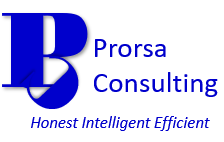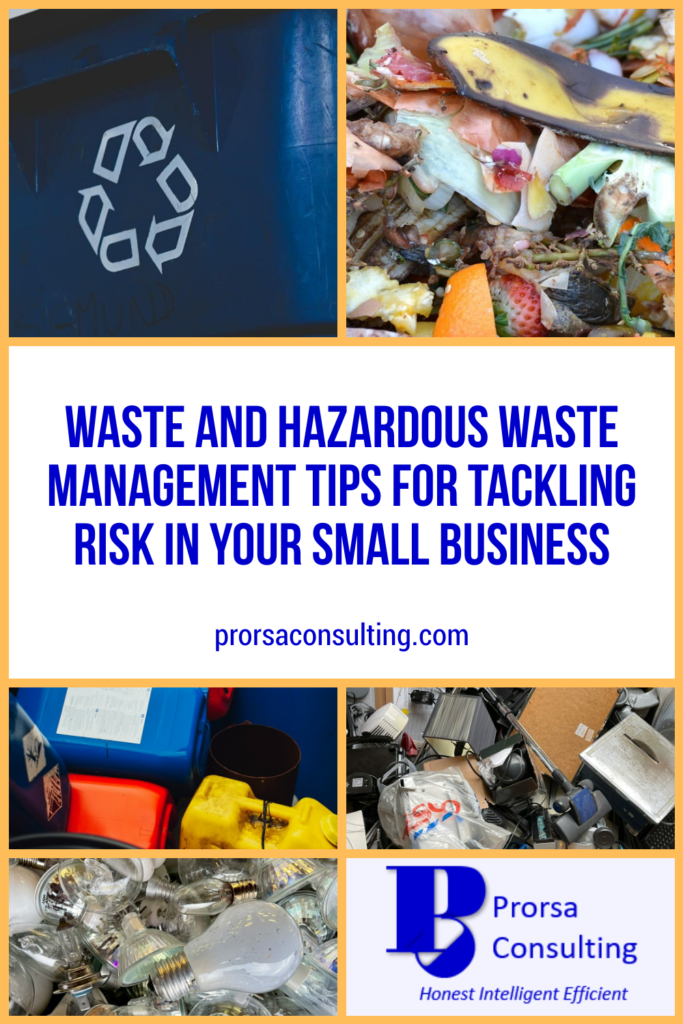Waste and Hazardous Waste Management Tips for Tackling Risk in Your Small Business
By : Admin -

Are waste and hazardous waste management concerns part of your enterprise’s strategic planning?
They should be. Our waste poses many challenges for us all. The Los Angeles Times reports that 624,700 metric tons of U.S. trash are generated daily. All this refuse contaminates the environment. Moreover, it requires us to expend natural resources to dispose of it. If the waste is hazardous, it creates additional threats to public health when handled poorly.
Furthermore, effective waste and hazardous waste management provides outstanding business benefits to companies. Operations lower their environmental compliance risk when they manage well. Organizations can realize cost savings when waste programs are implemented strategically. Subsequently, businesses may boost their reputations by committing to more sustainable solutions.
Companies’ consideration of this topic helps to secure wins for the business, community, and the environment. The information and actionable tips below can guide small enterprises in bolstering their waste management activities.
Waste and Hazardous Waste Management Defined
Strong waste management begins with understanding what waste is. The Code of Federal Regulations (CFR) defines solid waste as “garbage, refuse, sludges, and other discarded solid materials, including waste materials resulting from industrial, commercial, and agricultural operations and from community activities . . . “(40 CFR 243.101(y)).
Various types of waste exist under this definition. The categories of waste present at your site will directly impact the control programs designed.
Common Waste Types at Small Enterprises
Almost every small operation generates trash and garbage. Office paper, cardboard, expanded polystyrene foam, plastics, yard trimmings, and food scraps will be included here. This type of waste is usually disposed of as municipal solid waste.
Additionally, small enterprises may have other items for discard that are not regulated as hazardous. Examples include manufacturing/processing byproducts, used oil, cooking oil or grease, demolition debris, motor vehicle parts, and universal waste. Disposal of these items often requires contracting a specialized waste pick-up service.
Small businesses can also create hazardous waste at their facilities. Generally, waste in this category is listed (i.e., listed in the regulation) or characteristic (i.e., waste has a characteristic that makes it regulated as hazardous). While not regulated by the EPA, regulated medical waste is also generally considered dangerous. In these cases, stricter regulations exist around on-site control, accumulation, transport, treatment, storage, and disposal.
What Does Waste and Hazardous Waste Management Entail?
Waste management includes the methods used to prevent, control, and dispose of waste. It encompasses activities before, during, and after generation. By taking a systematic approach to waste and hazardous waste management, sites increase their potential to stay compliant.
Popular initiatives like “zero waste,” “go paperless,” and “reduce, reuse, recycle” are typical examples of strategies to manage substances usually slated for disposal. Traditional techniques include landfilling and incineration to handle waste. The drive for greater sustainability in business has prompted some companies to lean aggressively toward prevention tactics to stop waste before its formation.
Waste and Hazardous Waste Management Considerations
Organizations must evaluate their needs and desires before deciding on a waste strategy. A comprehensive status quo evaluation will provide valuable information to define the next steps.
Your Business Obligations
Organizations are required to comply with applicable legal requirements. To accomplish this, a company must determine what types of waste it generates. Small businesses may neglect to include expired chemicals, old pesticides, pieces of equipment or appliances, etc., when taking stock of waste.
After determining the waste generated on-site, companies can discern which regulations and codes apply. As distinct types of waste are regulated differently, a facility may need to meet multiple legal obligations. Furthermore, the requirements may change depending on the geographic location.
Your Business Wishlist
Strong waste and hazardous waste management can also help you achieve business targets. As such, organizations should also consider their values and current objectives. Doing so will ensure any waste management program aligns with the operation.
Is there a sustainability push in the operation? Are you looking to improve efficiency? Do you want to cut costs? Is giving back to the community important to the company? Answering questions like these will help pinpoint the kinds of waste and hazardous waste management actions that benefit the organization.
Hints for Effective Waste and Hazardous Waste Management
Begin with a waste audit.
It isn’t easy to manage what you don’t understand. Thus, conducting an audit is the first step for businesses to determine a suitable waste management strategy. The assessment will provide vital information to direct your efforts.
The audit should identify and categorize all the specific waste streams at the facility. Additionally, current on-site controls and final destinations of the waste must be noted. The evaluation should also detect any waste not managed in compliance with requirements.
Consider reintegrating waste into on-site activities.
Organizations can give new life to their waste by simply reusing it in-house. Doing so keeps these items out of the site’s waste streams, cutting the resources (time, staffing, and money) required for on-site management and disposal.
With their waste audit results, businesses can quickly identify wasted items and substances that could be reused at the facility. Can boxes or packaging materials from the company’s purchased products be reused for shipping other articles? May leftover paint be used for touchups in different parts of the facility? Can byproducts of an existing process be used as raw materials for a new product?
Assessing and implementing solutions like these are often part of a comprehensive zero-waste strategy. Businesses can efficiently reduce their environmental footprint by thinking innovatively about waste management.
Sell waste and hazardous waste for further beneficial use.
Your company may no longer have use for the waste generated at the facility, but other organizations or individuals might. Finding other entities to take your waste and put it to further beneficial use is preferable to sending it for disposal. A tiny amount of research might be required, but the potential dividends are worth it.
For starters, selling waste will move waste disposal from an activity that costs the business money to one that generates revenue. Likewise, the waste sales will reduce the company’s environmental footprint. Depending on the demand from the buyer, the seller may also find itself with decreasing amounts of waste to manage on-site.
Evaluate your local recycling and donation opportunities as a waste and hazardous waste management strategy.
The best waste and hazardous waste management strategies prevent materials from re-entering the environment as potential contamination. Waste recycling and donation redirect waste into processes that allow future consumption or use by others.
Organizations can recycle paper, plastic, cardboard, metals, and glass for use as post-consumer materials in the manufacture of new goods. Additionally, old furniture, food, appliances, clothing, etc., may be donated to charities to help those less fortunate.
Adopt an eco-friendly purchasing strategy.
Generation avoidance and material substitution can positively impact the effort and price associated with waste and hazardous waste management. By starting in the procurement process, business can more effectively shape their strategies for solid source reduction.
When embarking on a more environmentally conscious purchasing scheme, operations should begin by asking the following questions:
- Are there suitable replacements for our current materials that will generate less waste?
- Do options exist that will reduce the quantity of hazardous waste generated?
- Are vendors available that offer more sustainable packaging for the items we purchase?
- Could we procure items in bulk to decrease the packaging we receive on-site with our purchased materials?
If the answer to any of these questions is yes, then exploring potential solutions is worth the effort. Evaluate each option for feasibility, cost, and long-term availability. Engage with your procurement team in these assessments, and seek input from trusted industry contacts and your trade association.
Train, reinforce, and coach on waste and hazardous waste management.
Success comes from proper and consistent execution. Employees drive implementation but must have the knowledge and skills to do so. As such, it is vital to educate workers on the company’s chosen waste management methodology and its benefits.
The business should include waste and hazardous waste training as part of its initial and recurrent environmental training. Also, cover these topics in your environmental, health, and safety toolbox talks, meetings, and written communications to the workforce. Finally, supervisors and managers should coach individuals on the company’s chosen waste strategy when needed, just as with any other area of work performance.
Other Posts You May Enjoy
Universal Waste Fundamentals and Practical Tips To Help You Say Never Again To Noncompliance
Simple Ways to Dip Your Toe into Environmental Sustainability in Business Today
Environmental Pollution Prevention Strategies You Should Try Before Treatment
Closing Thoughts on Waste and Hazardous Waste Management
You can achieve on-site waste and hazardous waste management with solid knowledge and tactics. Companies can comply with environmental requirements and decrease risk by defining waste items, considering business needs and desires, and adapting suitable solutions to waste management.
Moreover, committing to continuous improvement in waste management will decrease the organization’s environmental footprint, positively impacting the planet and the bottom line. Remember, failure starts with an unwilling mindset. Evaluate diligently and act decisively to reap the benefits.






